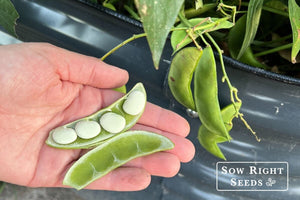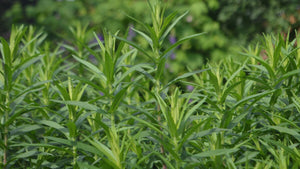The Best Way to Grow Perennial Rhubarb Plants in Your Home Garden
RhubarbRhubarb is a reliable heirloom plant that produces tart stalks that are popular in jams, pies, and sauces. If you've ever enjoyed this sour vegetable, your mouth may be puckering already. In this guide, we'll explain how to start growing rhubarb from seed so you can enjoy a delicious harvest year after year.

Rhubarb has been a popular plant in North American gardens for generations. On family farms, a rhubarb patch was a common sight. It is a reliable early spring crop that is easy to care for. Rhubarb plants are cultivated for their tart stalks that are used in cooking and baking. But their leaves are toxic and should not be eaten.
In cooking, rhubarb is often combined with sweet fruits like strawberries, apples, or raspberries to balance out its tartness. It is commonly used in making pies, jams, sauces, and compotes. The tart flavor adds a unique twist to desserts and is often paired with sugar or honey to create a harmonious blend of flavors. You can eat it raw, but wow! It will really make you pucker!
It thrives in temperate climates and prefers well-drained soil and full sun. Rhubarb can also tolerate cold temperatures, making it an ideal addition to gardens in cooler regions.
How to Grow Rhubarb From Seed
Rhubarb seeds can be started indoors 6 to 8 weeks before the last spring frost date. Or, in warmer climates, seeds can be direct sown outdoors in the fall.
Depending on your growing zone, you can grow rhubarb as an annual or perennial vegetable.

How to Germinate Rhubarb Seeds
To germinate rhubarb seeds, start by soaking the seeds in warm water for a few hours before planting. This will help soften the seed coat and promote germination.
Plant rhubarb seeds ¼ inch deep in seed starting mix.
Keep the soil moist but not waterlogged to encourage germination.
Place the pots in a warm location, ideally with a temperature range of 60-75°F.
It's important to provide a bright indoor spot to ensure the seeds receive ample light for germination.
Rhubarb seeds should sprout within two to three weeks. When the seedlings are still small, you can thin them out, leaving only the strongest seedling in each pot.
As the seedlings grow, continue to keep them in a bright indoor spot and water them regularly to ensure optimal growth. Watering from the bottom can help prevent damping off.
Once the seedlings have developed a few sets of true leaves and the weather has warmed up, they can be transplanted into a sunny outdoor location.

Transplanting Rhubarb Seedlings
Rhubarb seedlings can be transplanted outdoors once they are about 4 inches tall and have at least two true leaves.
In cold climates, you will want to wait until after the last spring frost. In warmer growing zones, seedlings can be transplanted in autumn.
Make sure to harden off rhubarb seedlings before transplanting outdoors. They will need time to transition to the outdoor growing conditions to avoid transplant shock.
How to Grow Rhubarb Plants
Growing and maintaining rhubarb plants is fairly simple. Take extra care in the first year with consistent watering and nutrient-rich soil to promote strong root growth.
Location is a crucial factor for rhubarb plants. Both for providing what it needs and for keeping it from overtaking and shading out other plants.
Sun
Rhubarb grows best in full sun. The summer heat can take its toll on rhubarb plants. You may want to shade your plants in warmer climates in late summer. For zones 8 and above, providing afternoon shade during hotter months can protect the plants from excessive heat and sun exposure, which can be detrimental to their growth.
Soil
Soil texture matters more than soil pH. Rhubarb can grow in neutral to acidic soil, but well-drained, loamy soil is crucial for the successful growth of rhubarb plants. This type of garden soil provides the right balance of moisture and aeration for the roots to thrive. It also prevents waterlogging, which can lead to root rot and other issues.
You can enrich your garden soil with well-rotted manure and compost to provide the necessary nutrients for the rhubarb plant.
As a perennial plant that can last more than 10 years, it is essential to start with excellent soil that drains well. Heavy clay soil will need to be amended before planting rhubarb.

Spacing
Space rhubarb plants about 3 feet apart. Depending on the variety and location, they can grow 3 to 5 feet tall and 3 feet wide.
Plan on rhubarb plants getting larger over the years. So choose a location where it can stay put for a very long time.
Water
Rhubarb requires about an inch of water per week, especially during the growing season. During dry periods, you will need to water in the early morning or late afternoon to prevent evaporation.
The first year is crucial for establishing a healthy root system, so it is important to consistently monitor the moisture levels and ensure the plant gets the necessary amount of water. Once established, rhubarb is relatively drought-tolerant, but it is still important to provide supplemental watering to avoid stress on the plant during dry spells.
Fertilizing Rhubarb Plants
Rhubarb is considered a heavy feeder. Which means it needs large amounts of nutrients to grow those big leaves and sour, juicy stems.
Having enough nutrients in the first year of growth is vital for developing a strong root system. One of the best ways to fertilize rhubarb is to incorporate compost into the soil. Compost provides essential nutrients and promotes healthy microbial activity in the soil, which is crucial for the growth of rhubarb plants.
To fertilize your rhubarb plants with compost, simply spread a layer of compost around the base of the plants, making sure not to cover the crown.
When growing rhubarb as a perennial, you can add additional compost or well-rotted manure each spring.

Harvesting Rhubarb
A strong root system is vital for perennial rhubarb plants. So wait until the second year before harvesting rhubarb stalks unless you are growing them as annuals.
The optimal time to start harvesting rhubarb is in the spring and early summer. Some of the stalks will have leaves, and some of the stalks will have flowers. The ones with leaves are the ones you want to harvest for eating.
When the stalks are at least 10-12 inches long, they are ready to harvest. To harvest rhubarb stalks, simply grasp them near the base, then pull and twist to remove them.
It’s important to leave at least half of the stalks on the plant during each harvest, as removing all the stalks at once can weaken the plant. Also, be sure to leave some leaves on perennial clumps, as they are essential for the plant to photosynthesize and store energy for the next growing season.

Harvested rhubarb stalks can be stored in the refrigerator for up to two weeks. After gathering the stalks, be sure to discard the leaves, as they are toxic and should not be consumed.
Rhubarb can also be frozen for longer-term storage. Before freezing, cut it into useable chunks for making pies and sauces.
Both frozen and fresh rhubarb can be made into all kinds of delicious recipes.
Rhubarb Pests and Diseases
Root rot can be a problem for rhubarb in some locations. It can be identified by yellowing or wilting leaves and a foul odor coming from the soil. Root rot is caused by overly wet soil or poor drainage. To prevent root rot and crown rot, ensure proper drainage and avoid overwatering.
Common pests that affect rhubarb include aphids, which can cause stunted growth and distorted leaves, and slugs, which leave behind slime trails and chew on the leaves.
Signs of aphids include clusters of small, soft-bodied insects on the underside of leaves and the presence of a sticky substance on the leaves known as honeydew. To control aphids, spray the affected plants thoroughly with insecticidal soap or neem oil.
Slugs leave behind chewed leaves and slimy trails, especially in wet weather. Slugs can be controlled by setting up beer traps and other natural methods.
One plus of rhubarb is that it isn't attractive to deer and rabbits. It can be grown in rural home gardens and be left alone.

Rhubarb FAQs
Some commonly asked questions about growing, caring for, and harvesting rhubarb include:
What care does rhubarb need?
Rhubarb requires regular watering, especially during dry spells, and benefits from a layer of mulch to retain moisture and suppress weeds. Fertilize rhubarb in early spring with compost or aged manure.
Can rhubarb grow in containers?
You can grow rhubarb in containers, but the pots need to be large. Rhubarb spreads through rhizomes and will quickly outgrow its pot. Plan on dividing your container-grown plants every few years. Also, make sure the pot drains well.
When is the best time to harvest rhubarb?
Rhubarb stalks can be harvested in the second or third year after planting. Stalks should be pulled, not cut when they are 10-12 inches long and firm. Only harvest up to half of the plant's stalks to allow it to continue growing.
Are rhubarb leaves toxic?
Yes, rhubarb leaves contain oxalic acid, which is toxic if ingested. Although you can't eat the leaves, you can use them in compost. After harvesting the stalks, cut off the leaves and add them to your compost bin.
Is rhubarb a perennial plant?
Rhubarb is a perennial that can live for many years if properly cared for. The leaves will die back in the fall, and the plant will go dormant in winter. Then, new shoots will grow when temperatures warm up in the spring. Rhubarb crowns should be divided every 4-5 years to maintain its vigor.
Growing Rhubarb as an Annual vs Perennial
Growing rhubarb as an annual or perennial depends largely on the climate zone. In cooler regions, rhubarb is typically grown as a perennial, coming back year after year. In warmer regions, it is often grown as an annual, replanting the crop each year.
The transplanting time will also vary for different growing zones. When growing rhubarb as an annual in warmer climates, the seedlings are planted out in the fall to mature in the cooler months. In colder growing zones, transplants are put out in the spring.

Rhubarb is one of those unique heirloom vegetables that evoke so many memories. The undeniable tangy taste and huge beautiful leaves have been part of the summer landscape for generations of farmers. If rhubarb pie is on your list of recipes, you'll want to add this traditional favorite to your garden.
Start planting rhubarb with reliable heirloom seeds from Sow Right Seeds.
Victoria Rhubarb (Rheum rhabarbarum) grows large, tender stalks that gradually fade from deep crimson to green. Victoria is a sweet, mild tasting rhubarb that is grown throughout the US. This productive variety grows up to 3 feet tall and can live for 10 years or more in colder regions.




Leave a comment